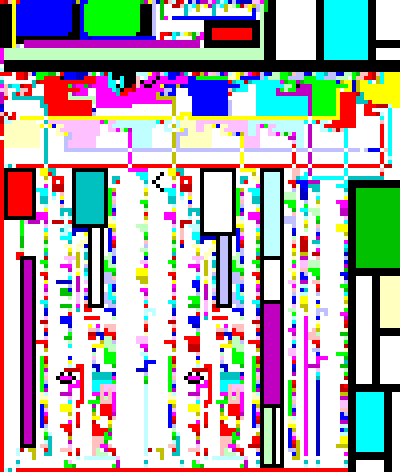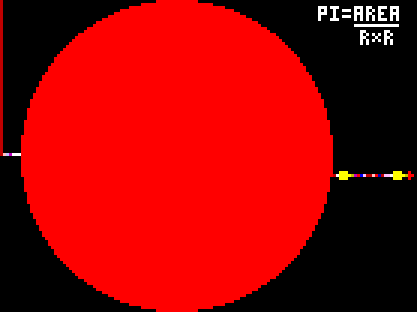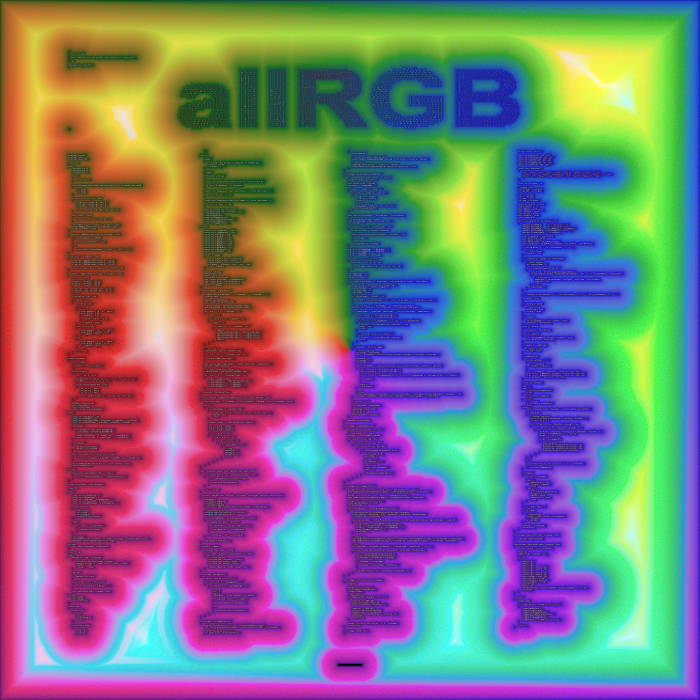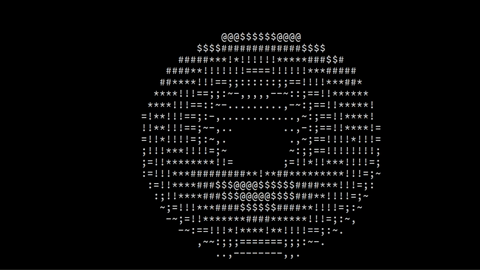Programming
Piet
Hello World in Piet with the matching pixel art by Kelly Boothby.

Another great work of art is Matthias Ernst piet programm which inteprets brainfuck.

There are also attempts to write a piet program and a piet like art work.
One last great example for a piet program which I like a lot is by Richard Mitton. This program calculates an approximation of pi by dividing a circular area by the radius twice. A more accurate value can be obtained by using a bigger program and therewith circle :)

AllRGB
The objective of allRGB is simple: To create images with one pixel for every RGB color (16,777,216); not one color missing, and not one color twice.
This picture from yashe includes it's own code.

Donut
Code in the shape of a donut creating a rotating donut :)
Source:
- Original: https://www.a1k0n.net/2006/09/15/obfuscated-c-donut.html
- Update 1: https://www.a1k0n.net/2006/09/20/obfuscated-c-donut-2.html
- Update 2: https://www.a1k0n.net/2011/07/20/donut-math.html
- Update 3: https://www.a1k0n.net/2021/01/13/optimizing-donut.html
C code:
i,j,k,x,y,o,N;
main(){float z[1760],a
#define R(t,x,y) f=x;x-=t*y\
;y+=t*f;f=(3-x*x-y*y)/2;x*=f;y*=f;
=0,e=1,c=1,d=0,f,g,h,G,H,A,t,D;char
b[1760];for(;;){memset(b,32,1760);g=0,
h=1;memset(z,0,7040);for(j=0;j<90;j++){
G=0,H=1;for(i=0;i<314;i++){A=h+2,D=1/(G*
A*a+g*e+5);t=G*A *e-g*a;x=40+30*D
*(H*A*d-t*c);y= 12+15*D*(H*A*c+
t*d);o=x+80*y;N =8*((g*a-G*h*e)
*d-G*h*a-g*e-H*h *c);if(22>y&&y>
0&&x>0&&80>x&&D>z[o]){z[o]=D;b[o]=(N>0
?N:0)[".,-~:;=!*#$@"];}R(.02,H,G);}R(
.07,h,g);}for(k=0;1761>k;k++)putchar
(k%80?b[k]:10);R(.04,e,a);R(.02,d,
c);usleep(15000);printf('\n'+(
" donut.c! \x1b[23A"));}}
/*no math lib needed
.@a1k0n 2021.*/
javascript version:
(function() {
var _onload = function() {
var pretag = document.getElementById('d');
var canvastag = document.getElementById('canvasdonut');
var tmr1 = undefined, tmr2 = undefined;
var cA=1, sA=0, cB=0, sB=1;
var R=function(tanangle, x, y) {
var tmp=x;
x -= tanangle*y;
y += tanangle*tmp;
tmp = (3-x*x-y*y)/2;
x *= tmp;
y *= tmp;
return [x, y];
}
var asciiframe=function() {
var b=[];
var z=[];
var xy = R(.04, cA, sA);
cA = xy[0]; sA = xy[1];
xy = R(.02, cB, sB);
cB = xy[0]; sB = xy[1];
for(var k=0;k<1760;k++) {
b[k]=k%80 == 79 ? "\n" : " ";
z[k]=0;
}
var sj = 0, cj = 1;
for(var j = 0; j < 90; j++) {
var si = 0, ci = 1;
for(var i = 0; i < 314; i++) {
var h=cj + 2,
D=1/(si*h*sA+sj*cA+5),
t=si*h*cA-sj*sA;
var x=0|(40+30*D*(ci*h*cB-t*sB)),
y=0|(12+15*D*(ci*h*sB+t*cB)),
o=x+80*y,
N=0|(8*((sj*sA-si*cj*cA)*cB-si*cj*sA-sj*cA-ci*cj*sB));
if(y<22 && y>=0 && x>=0 && x<79 && D>z[o]) {
z[o]=D;
b[o]=".,-~:;=!*#$@"[N>0?N:0];
}
xy = R(.02, ci, si);
ci = xy[0]; si = xy[1];
}
xy = R(.07, cj, sj);
cj = xy[0]; sj = xy[1];
}
pretag.innerHTML = b.join("");
};
window.anim1 = function() {
if(tmr1 === undefined) {
tmr1 = setInterval(asciiframe, 50);
} else {
clearInterval(tmr1);
tmr1 = undefined;
}
};
asciiframe();
}
if(document.all)
window.attachEvent('onload',_onload);
else
window.addEventListener("load",_onload,false);
})();
This is how it looks like:
